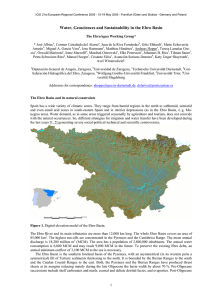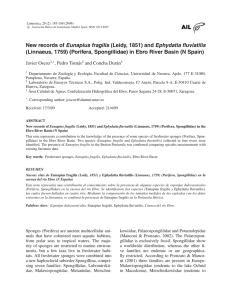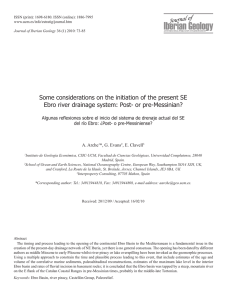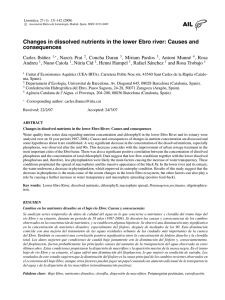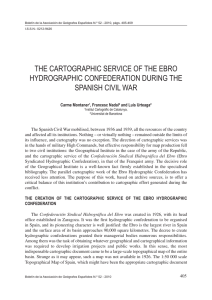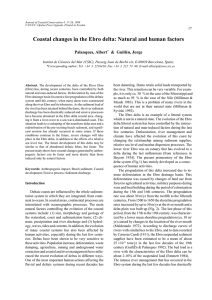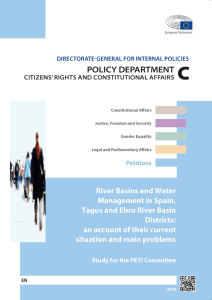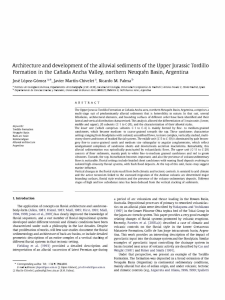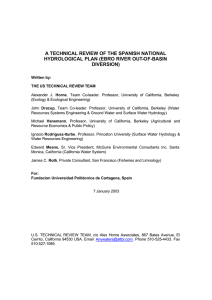River Ebro basin
Anuncio
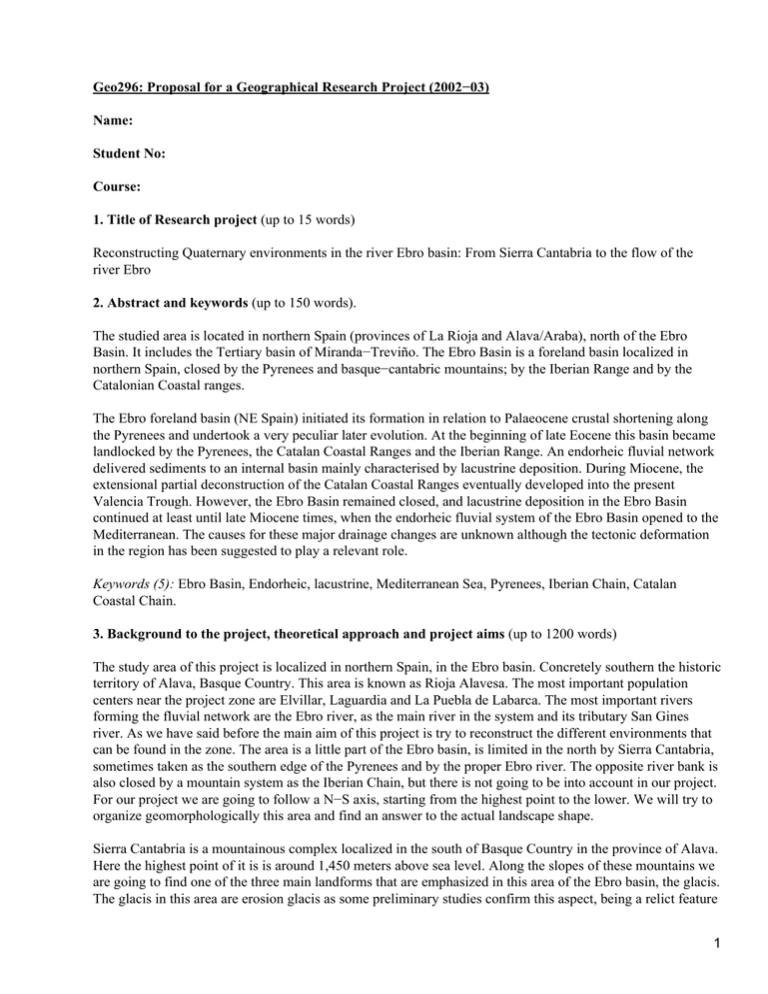
Geo296: Proposal for a Geographical Research Project (2002−03) Name: Student No: Course: 1. Title of Research project (up to 15 words) Reconstructing Quaternary environments in the river Ebro basin: From Sierra Cantabria to the flow of the river Ebro 2. Abstract and keywords (up to 150 words). The studied area is located in northern Spain (provinces of La Rioja and Alava/Araba), north of the Ebro Basin. It includes the Tertiary basin of Miranda−Treviño. The Ebro Basin is a foreland basin localized in northern Spain, closed by the Pyrenees and basque−cantabric mountains; by the Iberian Range and by the Catalonian Coastal ranges. The Ebro foreland basin (NE Spain) initiated its formation in relation to Palaeocene crustal shortening along the Pyrenees and undertook a very peculiar later evolution. At the beginning of late Eocene this basin became landlocked by the Pyrenees, the Catalan Coastal Ranges and the Iberian Range. An endorheic fluvial network delivered sediments to an internal basin mainly characterised by lacustrine deposition. During Miocene, the extensional partial deconstruction of the Catalan Coastal Ranges eventually developed into the present Valencia Trough. However, the Ebro Basin remained closed, and lacustrine deposition in the Ebro Basin continued at least until late Miocene times, when the endorheic fluvial system of the Ebro Basin opened to the Mediterranean. The causes for these major drainage changes are unknown although the tectonic deformation in the region has been suggested to play a relevant role. Keywords (5): Ebro Basin, Endorheic, lacustrine, Mediterranean Sea, Pyrenees, Iberian Chain, Catalan Coastal Chain. 3. Background to the project, theoretical approach and project aims (up to 1200 words) The study area of this project is localized in northern Spain, in the Ebro basin. Concretely southern the historic territory of Alava, Basque Country. This area is known as Rioja Alavesa. The most important population centers near the project zone are Elvillar, Laguardia and La Puebla de Labarca. The most important rivers forming the fluvial network are the Ebro river, as the main river in the system and its tributary San Gines river. As we have said before the main aim of this project is try to reconstruct the different environments that can be found in the zone. The area is a little part of the Ebro basin, is limited in the north by Sierra Cantabria, sometimes taken as the southern edge of the Pyrenees and by the proper Ebro river. The opposite river bank is also closed by a mountain system as the Iberian Chain, but there is not going to be into account in our project. For our project we are going to follow a N−S axis, starting from the highest point to the lower. We will try to organize geomorphologically this area and find an answer to the actual landscape shape. Sierra Cantabria is a mountainous complex localized in the south of Basque Country in the province of Alava. Here the highest point of it is is around 1,450 meters above sea level. Along the slopes of these mountains we are going to find one of the three main landforms that are emphasized in this area of the Ebro basin, the glacis. The glacis in this area are erosion glacis as some preliminary studies confirm this aspect, being a relict feature 1 of past cold episodes in this zone. Looking carefully to these structures will be able to see that there is a succession of different materials as long as we move closer to the glacis edges. In a first stage we will find conglomerates and sandstones. In lower parts of the glacis there are some layers of fine sandstones, clays and carbonates. And finally in the closer places to the edges we will find gypsum and salts. This succession of different materials is consequence of an old continental deposition phase occurred during the eocene. But after this period (the Ebro was a endorheic basin), the basin opened again to the Mediterranean Sea, that is why the glacis became erosive. As it was a new base level in the Mediterranean Sea, a new fluvial network started to operate in zone. This new base level was lower so the rivers began to erode the landscape given rise to new landforms. Another important point to localize is that the mentioned sandstones have been able to preserve old forms in their extructure. Thus studying carefully those sediments we should be able to recognize some forms such as antique palaeochannels. The next step as long as we move down to the talweg is to identify the edges of the glacis. Sometimes they are very clear and it is possible to find out them in the aerial or satellite image. Other times we are going to have to use leveling data and sediment analysis. And then we have to discover if each glacis corresponds with a terrace level. Another important aspect would be to identify the points of contact or assemblages between the terraces and the glacis if there are. The next step would be to identify and correlate the different levels of terraces. Fluvial terraces are abandoned floodplains and/or erosional surfaces. They are fluvial forms formed by combinations of accumulation or aggradation of fluvial deposits and subsequent incision or degradation by the stream. Note that incision is required for landform to be preserved as terrace. Some works have identified a minimum of two levels of terrace in this area. The geological mapping of the area reaffirms this data, but many times it has occurred that this cartography was wrong. Our work is to find out their localization, analyze, correlate and date them, and if we find that there is any gap, fail or anything wrong in the official data, try to fix it. And one of the most important aspects is to spot the processes that have formed this elevations, we have different options like: −No simple explanation or triggers. However, in general one can say that fill terrace implies excess of sediment load compared with discharge, degradational terrace implies opposite. Furthermore, downcutting by rivers is not uniform; thus have progressive halts in downcutting history−−and multiple terrace sequences. −Aggradation can be triggered by glacial outwash, climate change, changes in base level, slope, or load due to sea level change and/or tectonism. Accumulations also triggered locally by unusual depositional events, as in large debris flow episodes. −Incision also can be triggered by climate change and changes in base level or slope. So taking into account the results of the analysis of our data, we should be capable to develop a theory that can explain the formation of these features. Finally, we have a last level referred to today's floodplain situated next to the Ebro river. In summary, we can say that the project is based on the analysis of three different forms: glacis, terraces, floodplain. To get a successful attempt in this project we have to follow the different steps that are going to be specified behind in the text. In short we can say that the methodology is summarized in mapping, instrumental leveling, use of GPS (Global Positioning System), aerial photography, satellite images, sediment analysis/sedimentology and dating. Project aims: We have different aims in this project, starting by: − Geomorphological analysis of a zone of the Ebro basin that is more or less unknown. The Ebro basin is one 2 of the most important basins in Spain with the Guadalquivir basin in southern Spain. This area has been well studied along the last decades. However, this part of the basin has not been as much studied as others like the Ebro during its flowing along the autonomous regions of Aragon and Cataluña. So I think that it is important to try to start covering the gap existent in this sector. The landforms and the processes are well known but the important aspect is the area. This has been a rural portion of the basin has been nearly forgotten and it is now a good opportunity to repair this problem. − Dating of the different features to compare the results with the other projects that have been carried out in the basin. The extructure of the basin and its landforms are more or less quite similar along it, so if we date them, we can correlate with other sites that have been studied. So in the future if the available data is wide enough, a continuous geomorphological map of the basin can be develop with a scale of detail good enough. Nowadays, there is cartography referred to this topic but the scale is very small and depending on the objectives of some project is useless. − To fix the possible errors in the cartography of the study area. Some of the cartography developed by the Basque Country government has different problems and gaps that can be partially solved with a good project. Taking into account the different measurements that we are going to take, we should be able to do a good cartography of the study area. − To find out the processes occurring nowadays to avoid possible problems, for example erosion. Do not forget that this is one of the most important vine−production zone in Spain. The Rioja wine is very important for the region and many people depends on the well future of this product. So taking advantage our work, we can help to the good working of this economic sector. The changes can be seen in the field because the previous work with the aerial photography shows us how the landscape was forty years ago, then we will see the different processes occurring today. 4. Specific objectives of the project (up to 150 words) The main aim of the project is to try to realize a complete geomorphological analysis from the top of the mountains (Sierra Cantabria) to the base level or talweg situated in the Ebro river. The evolution of this river and the fluvial network associated has organized the landscape of this zone into different levels of terraces. We can also find glacis starting from the mountain edges. Other elements that can be found when the project will carry out. Once we have identified all the features, try to understand the processes that have created them. Then localize the processes that are occurring in the present and help to solve the problems that can occurred such as bank erosion (this zone is an important vine−producing area). The existent cartography has some gaps and fails that can be partially fixed with a good surveying and leveling that can be carried out for our project. 5. Methodology and approach (up to 500 words) To carry out our project, the field work and its methods play a vital role. We will follow this scheme: − Mapping The production of a map illustrating the distribution of the principal landforms is the first stage. Typical morphological maps are produced at scales of 1:10 000 or larger, for even the most subtle changes in the shape of the land are often recorded. Geomorphological mapping is one of the most important techniques, the maps produced contain not only information on morphology but also on the genesis and on the age of the landforms. . Geomorphological mapping is essentially interpretative and therefore requires both an appreciation of the complexity of landform assemblages and a detailed knowledge of their genesis. 3 − Instrumental levelling It is often essential to determine the precise altitude of, and differences in altitude between, particular landforms and landforms assemblages. The same applies equally to lithological units. Altitudinal data can aid in the interpretation of landform assemblages, and may also enable landforms of different age to be identified. For example, fragments of terraces, as the ones we are going to analyze. The comparison of altitudes of landforms, especially from separated localities, requires a common datum, a plane of know altitude to which all subsequent measurements can be referred. Altitudinal data are reliable when related to national survey bench marks. − GPS (Global Positioning System) This is a relative recent innovation that is proving to be an important aid. This is a method of triangulation based on the computation of distance between a point in the earth's surface and a number of earth−orbiting satellites. Using receivers, `satellite ranging' enables the position of any point on the surface of the earth. Once the location of a point is known, the altitude above sea level can also be calculated using the same system. This system has an extremely important value in fieldwork, especially in remote terrain distant from survey datum points. − Aerial photography This technique consists in a plane taking photographs of the earth's surface. Good quality photographs are now available, allowing at least preliminary maps to be made of clearly defined landforms and landform assemblages. A system of grid corrections can be used for transferring details from photographs to maps where scales differ, or where the photographs contain serious distortions. These photographs are especially useful because you can attend a huge area avoiding wasted ground reconnaissance, they reveal larger−scale landform patterns that may go undetected in ground mapping, or obscured by afforestation, urbanization, etc. − Satellite imagery This technique is based in the same principle as the aerial photographs but are taken by satellites, not by planes. The great advantage over aerial photography is that distorsions are minimized, the process is much more rapid, and repetitive images of large parts of the earth's surface can be obtained. The images available are different like the photographs of the Landsat, Spot, Tiros, Noaa. − Sedimentology A description of the basic properties of geomorphological materials is the most important starting point for an explanation of a geomorhological process. To do a good sediment description, we have to describe some parameters such as: verbal description of sediment texture, clast size, sorting, matrix, clast shape (roundness and sphericity, and form) fabric (packing, orientation, dip) sediment colour (hue, brightness, chroma) clast litology and organic, fossil & trace fossil content. Once we have analyze all the data, we should be able to identify the processes that created the features we have analyzed. − Dating Many of the dating techniques can only be applied to restricted spans of Quaternary research. Each method has its own distinctive set of problems which lead to uncertainties in interpretation. We have different possibilities like radiocarbon dating, potassium−argon and argon−argon dating, uranium−series dating,As we said, each method has its own problems, so we should find out which is the most suitable for our project. 4 With all these activities we can have an idea of how the landscape was created and the possible future view of the study area taking into account the processes that are occurring nowadays. 6. Program and/or plan of research (up to 500 words) One of the major difficulties of this project is that it has to be developed in Spain as we can see in the title of it. Consequently it has to be carried out during vacancy periods as Summer, Christmas and Easter. So dividing the project between these periods we can do a program like this: − Summer 2003 This first period will be the first step in the project. The summer can be divided between two periods: Monday − Thursday / Friday − Sunday. During the week, we will start the ground reconnaissance of the surface by the analysis of the aerial photographs (it would be very useful to get the geologic map of the zone), the needed photographs were taken in September 1968 and are the following: *Passing Nº of photography 23 9115 9116 9117 24 9092 9093 9094 25 9066 9067 9068 26 9036 9037 9038 27 9023 9024 9025 *Geologic map: E.V.E geologic map of Basque Country 1:25 000, the zone of Lagurdia (Alava) The photographs we are going to use are pretty old because the availability of them in the University of the Basque Country does not represent any problem. On other hand, these photographs will allow us to interpret the study area without the human development that have occurred in the last decades. With the interpretation of the data, we can do a first shallow geomorphological map that can be very useful in these first stages of the project. This first attempt will be fixed during the next fieldwork sessions. If there are available, the satellite images will be very useful, but the availability of them is unknown. Once we have started the fieldwork, the week sessions will be used to analyze the primary data that we are going to get from the fieldworks. On other hand, the weekend during this period will be used to ground reconnaissance with the main aim to make oneself familiar with the landscape. At some stage we will be able to take some notes, sketches and pictures. This data will allow us to complete the geomophological map and fix the probable fails in it. During the fieldworks we must bring with us the GPS to take the exact coordinates of all the features we consider important of mention like terraces, palaeochannels, etc. At the end of this period a complete geomorphological map must be done with some data of localization. 5 −Christmas 2003 During this period, once we have done the geomorphological map, we will start with the surveying and leveling of the features appearing in the map and the calculations of the different slopes. To start doing this activity we need the leveling kit that can be lent by the University of Basque Country (so we do not need to carry it from Newcastle to Spain). To complete this part of the project we will need help of, at least, another person to take the readings. We have to try to finish the readings during this period. − Easter 2004 In Easter, we will finish the readings that are left from Christmas time. Once we have finished, we must start with the sediment analysis. Try to finish the sedimentology and take different samples for the laboratory analysis. After all the fieldwork, analysis, etc we are able to give an explanation of the landscape. 7. Resources and training required (i) Sources of secondary data Description of items References Maps Where available University of Newcastle upon Tyne, Cost (if applicable) University of Basque Country 0 0 (ii) Travel and subsistence Destination and purpose (a) Within the UK Newcastle−London b) Overseas London−Bilbao Bilbao−Tolosa Tolosa−Study area (Alava and La Rioja) Number of trips Mode of Transport 8 Plane 8 Plane 8 Bus 15 weekends (minimum) Car (iii) Equipment and laboratory facilities Description of items / facility Details of training required Where available (with costs if applicable) Laboratory practicals University of Newcastle upon Tyne Interpretation of satellite images University of Basque Country Physical Geography Laboratory Photo interpretation equipment Aerial photography Sediment dating laboratory Satellite photography 6 Geological maps Sediment dating (iv) Other requirements (e.g. IT / software packages) Details of training required Where available (with costs if applicable) GPS Leveling training University of Newcastle upon Tyne Laptop GPS training University of Basque Country GIS (Idrisi) AutoCad Basque Government Description Surveying and leveling kit AutoCad maps of the region 8. Transferable skills acquired by undertaking the project and potential contribution to career development (up to 200 words) Carrying out a project like this you acquire different skills. For example you need a good knowledge about how interpret aerial photographs and if there are available, satellite images. This is an interesting point because the rapid development of the science in themes about remote sensing (satellite images) make one to pay attention to all those innovations that maybe, in the future, could be a way to find a job. Probably in not many years this kind of images will be more expanded and we should be ready to analyze them. Another aspect is the use of leveling kit, with all the readings and measurements that we are going to take, we should acquire a deep knowledge about the running of the instruments, without forget the huge possibilities of the calculations you can do with the taken data. Apart we will obtain a base cal knowledge of GPS. Apart from these `technical' points, this year we have started our experience with sediment analysis, with this work we will able to get a deeper notions about this part of the geomorphology and one important point is that we will be in different environments so the sediment analysis will be very interesting. On the other hand, we will have the first contact with dating. This year we are having the basic ideas about it, and with this project we will be capable to put these ideas in practice. These are the most important abilities that you can develop carrying out a project like this and in the future can be useful to find a job. 9. Outline any ethical issues raised by your research proposal (up to 150 words) One of the most important is the possible help that one can offer to an important economic sector as the vine industry in this region. This is a traditional rural area, where the economic motor is the vine commerce. The other activities are not as important as the vine industry in workers neither in economic importance. The other significant activities are the grain agriculture and grazing, but as we say, they are far from the vine business. So if we can help to the development and conservation of this business will be very useful because this will contribute to the economic improvement of the area. Other important point is the relationship with the University of Basque Country that will collaborate with some material to the good working of the project. This can be the start of inter−universities collaboration. The department of Geography is situated in Vitoria (Alava), 40 km away from the study area, so their assistance will be extremely useful. Otherwise, all the material will have to be carried from Newcastle. We have to take 7 into account that I was a student of this University and the relationship with the staff there is very good so it is no going to represent any problem. So we should be pleased of their help and show them our gratitude. In my opinion these are the central ethical issues of this project, that hopefully we will deal with them. 10. References (no less than 20) Abalos B. ; Llanos H.J. Structure of the "Sierra de Cantabria' (Southern Pyrenean Frontal Thrust, Basque Country, Spain): a new perspective from section balancing Comptes Rendus − Academie des Sciences, Serie II: Sciences de la Terre et des Planetes 319, no.4 (1994) p. 475−481. Alonso B.; Field M.E.; Gardner J.V. ; Maldonado A Sedimentary evolution of the Pliocene and Pleistocene Ebro margin, northeastern Spain Marine Geology 95, no.3−4 (1990) p. 313−331. Andres W.; Ries J.; Seeger M. Pre−Holocene sediments in the Barranco de las Lenas, Central Ebro Basin, Spain, as indicators for climate−induced fluvial activities Quaternary International 93−94 (2002) p. 65−72. Angel Sanchez J.; Perez A.; Coloma P.; Martinez−Gil J. Combined effects of groundwater and aeolian processes in the formation of the northernmost closed saline depressions of Europe: north−east Spain Hydrological Processes 12, no.5 (1998) p. 813−820. United Kingdom. Arauzo T. ; Gutierrez−Elorza M. ; Sancho C Scarp retreats in semi−arid environments developing to talus flatirons (Ebro Basin) Cadernos Laboratorio Xeoloxico de Laxe 21 (1996) p. 405−416. Arenas C. ; Millán H. ; Pardo G. ; Pocovi A Ebro Basin continetal sedimentation associated with late compressional Pyrenean tectonics (North−Eastern lberia): Controls on basin margin fans and fluvial systems Basin Research 13, no.1 (2001) p. 65−89. Arenas C.; Pardo G. Latest Oligocene−Late Miocene lacustrine systems of the north−central part of the Ebro Basin (Spain): Sedimentary facies model and palaeogeographic synthesis Palaeogeography, Palaeoclimatology, Palaeoecology 151, no.1−3 (15 JUL 1999) p. 127−148 Netherlands. Arlegui L.E. ; Soriano M.A. Lineaments and their influence on the landscape of the central Ebro Basin Cadernos Laboratorio Xeoloxico de Laxe 21 (1996) p. 11−21. Arlegui L.E. ; Soriano M.A. Characterizing lineaments from satellite images and field studies in the central Ebro basin (NE Spain) International Journal of Remote Sensing 19, no.16 (1998) p. 3169−3185. Arlegui L. ; Simón J.L. Geometry and distribution of regional joint sets in a non−homogeneous stress field: Case study in the Ebro basin (Spain) Journal of Structural Geology 23, no.2−3 (2001) p. 297−313. Barnolas A. ; Gil−Pena I. Examples of multiepisodic infill in a fragmented foreland basin: The South−Pyrenean basin case study Boletin Geologico y Minero 112, no.3 (2001) p. 17−38. Benito, G; Machado M.J; Gutierrez F; Perez−Gonzalez A. Geomorphological and sedimentological features in Quaternary fluvial systems affected by solution−induced subsidence (Ebro Basin, NE−Spain) Geomorphology 33, no.3−4 (2000) p. 209−224 Netherlands.Benito, G; Machado M.J; Gutierrez F; Perez−Gonzalez A. River response to Quaternary subsidence due to evaporite solution (Gallego River, Ebro Basin, Spain) Geomorphology 22, no.3−4 (1998) p. 243−263 Netherlands. Boggs, S. Jr. 2001 Principles of Sedimentolgy and Stratigraphy 3rd Edition, New York: Prentice Hall. 8 Bradshaw, M & Weaver, R (1993) Physical geography Mosby. 640 pp Casas A.M. ; Simon J.L. ; Gil I. ; Leranoz B. ; Millan H. Quaternary reactivation of flexural−slip folds by diapiric activity: example from the western Ebro Basin (Spain) Geologische Rundschau 83, no.4 (1994) p. 853−867. Casas Sainz A.M Oblique tectonic inversion and basement thrusting in the Cameros Massif (northern Spain) Geodinamica Acta 6, no.3 (1993) p. 202−216. Gomez Pineiro J. ; Saez Garcia J.A. Cartograhy of the physical environment of the autonomous communities of the Basque country and Navarra Lurralde 14 (1991) p. 27−116. Gomez Villar A. Morphometric characteristics and typology of alluvial fans in The Rioja and the Aragonese Pyrenees Cadernos Laboratorio Xeoloxico de Laxe 21 (1996) p. 721−736. Gonzalo Moreno, A.N. El relieve de La Rioja Logroño, Diputación de Logroño, 1981. González−Sampériz P. ; Sopena Vicién M.C. Recent Holocene palaeoenvironmental evolution in the Central Ebro Basin (NE Spain) Quaternary International 93−94 (2002) p. 177−190. Goudie , A (1994) Geomorphological techniques Routledge. 570 pp. Guimera J. ; Alonso A. ; Ramon Mas J Inversion of an extensional−ramp basin by a newly formed thrust: the Cameros Basin (N. Spain) Geological Society, London; Special Publication, 88 (1995) p. 433−453. Gutierrez Elorza, M Geomorfologia de España Madrid, Rueda, 1997. Heintz Siggerud E.I. ; Steel R.J Architecture and trace−fossil characteristics of a 10,000−20,000 year, fluvial−to−marine sequence, se Ebro Basin, Spain Journal of Sedimentary Research, Section B: Stratigraphy and Global Studies 69, no.2 (1999) p. 365−383. Herraiz M. ; González−Casado J.M. ; Vadillo O. ; Rodríguez−Pascua M.A. ; Cicuéndez J.I. ; Casas A. ; Cabanas L. ; Rincón P. ; Cortés A.L. ; Ramirez M. ; Lucini M. ; Vicente G.D. ; Lindo−ñaupari R. ; Simón J.L. The recent (upper miocene ot quaternary) and present tectonic stress distributions in the Iberian Peninsula Tectonics 19, no.4 (2000) p. 762−786. Hirst J.P.P. Variations in alluvial architecture across the Oligo−Miocene Huesca fluvial system, Ebro Basin, Spain SEPM; Concepts in Sedimentology and Paleontology, 3 (1991) p. 111−121. Jones, A (et al) 2000 Practical skills in environmental science Prentice Hall. 290 pp. Llanos H. ; Quinif Y. ; Abalos B. Recent geodynamic evolution of the Sierra de Cantabria (Alava) based on U/Th dating of continental carbonates of the Inglares and Ebro river basins Boletin Geologico y Minero 109, no.1 (1998) p. 3−12. Lloyd M.J. ; Nichols G.J. ; Friend P.F. Oligo−Miocene alluvial−fan evolution at the southern Pyrenean thrust front, Spain Journal of Sedimentary Research, Section A: Sedimentary Petrology and Processes 68, no.5 (1998) p. 869−878. López−Blanco M. Sedimentary response to thrusting and fold growing on the SE margin of the Ebro basin (Paleogene, NE Spain) Sedimentary Geology 146, no.1−2 (2002) p. 133−154. 9 Lowe, j.j; Walker M.J.C (1997) Reconstructing quaternary environments (2nd Edition) Longman, London 445 pp. Lugaresaresti J.I. ; Saenz M.A. Pedagogical perspectives on geomorphology. The trial of role−play games applied to flood processes Cadernos Laboratorio Xeoloxico de Laxe 21 (1996) p. 203−212. Macklin, M.G; Passmore, D. Pleistocene environmental change in the Guadalope Basin, northeast Spain: fluvial and archaeological records Mediterranean Quaternary river environments (1995) p. 103−113. Maldonado A. ; Nelson C.H The Ebro margin study, northwestern Mediterranean Sea − an introduction Marine Geology 95, no.3−4 (1990) p. 157−163. Martinez de Pison, E. Guia fisica de España. Madrid, Alianza, 1986. Miegebielle V. ; Coquelet D. ; Hervouet Y. ; Pisot N. ; Xavier J.−P. Nouvelle methode d'etude des bassins sedimentaires: approche en 3 dimensions a partir des images du satellite SPOT. A new method of studying sedimentary basins: 3 dimensional approach using SPOT satellite images Bulletin − Centre de Recherches Exploration−Production Elf−Aquitaine 17, no.2 (1993) p. 331−351. Morisawa, M Geomorphology laboratory manual: with report forms New York, John Wiley & Sons, 1976. Morris R.G. ; Sinclair H.D. ; Yelland A.J. Exhumation of the Pyrenean Orogen: implications for sediment discharge Basin Research 10, no.1 (1998) p. 69−85. Muñoz A. ; Ojeda J. ; Sánchez−Valverde B Sunspot−like and ENSO/NAO−like periodicities in lacustrine laminated sediments of the Pliocene Villarroya Basin (La Rioja, Spain) Journal of Paleolimnology 27, no.4 (2002) p. 453−463. Muñoz A. ; Pardo G. ; Villena J. Palaeographic evolution of Miocene conglomerates adjoining the northern border of the Sierra de Cameros, La Rioja Acta Geologica Hispanica 27, no.1−2 (1992) p. 3−14. Nichols G.J. ; Hirst J.P. Alluvial fans and fluvial distributary systems, Oligo−Miocene, northern Spain: contrasting processes and products Journal of Sedimentary Research, Section A: Sedimentary Petrology and Processes 68, no.5 (1998) p. 879−889. Riba Arderiu O. ; Jurado M.J Reflexiones sobre la geologia de la parte occidental de la Depresion del Ebro. Reflections on the geology of the western part of the Ebro Depression Acta Geologica Hispanica 27, no.1−2 (1992) p. 177−193. Riba Arderiu O. Oblique sequences in the northern border of the Ebro Depression in Navarra and the Barbarin unconformity Acta Geologica Hispanica 27, no.1−2 (1992) p. 55−68. Ries J.B. ; Marzolff I. Identification of sediment sources by large−scale aerial photography taken from a monitoring blimp Physics and Chemistry of the Earth 22, no.3−4 (1997) p. 295−302. Salvany J.M. ; Munoz A. ; Perez A. Nonmarine evaporitic sedimentation and associated diagenetic processes of the southwestern margin of the Ebro Basin (Lower Miocene), Spain Journal of Sedimentary Research A: Sedimentary Petrology & Processes 64 A, no.2 (1994) p. 190−203. Sanchez J.A. ; Coloma P. ; Perez A. Sedimentary processes related to the groundwater flows from the Mesozoic Carbonate Aquifer of the Iberian Chain in the Tertiary Ebro Basin, northeast Spain Sedimentary Geology 129, no.3−4 (1999) p. 201−213 Netherlands. 10 Sancho C. ; Melendez A. ; Signes M. ; Bastida J. Chemical and mineralogical characteristics of Pleistocene caliche deposits from the central Ebro Basin, NE Spain Clay Minerals 27, no.3 (1992) p. 293−308. Skinner, B.J & Porter, S.C. (1997) Physical geology Wiley. 750 pp. Soriano M.A Infilled valleys in the central Ebro Basin (Spain) Catena 16, no.4−5 (1989) p. 337−367. Vincent S.J. The Sis palaeovalley: A record of proximal fluvial sedimentation and drainage basin development in response to Pyrenean mountain building United Kingdom. Sedimentology 48, no.6 (2001) p. 1235−1276 Valero−Garcés B.L ; González−Sampériz P. ; Kelts K. ; Delgado−Huertas A. ; Navas A. ; Machín J. Quaternary palaeohydrological evolution of a playa lake: Salada Mediana, central Ebro Basin, Spain Sedimentology 47, no.6 (2000) p. 1135−1156. Verges J. ; Burbank D.W. ; Munoz J.A. ; Gimenez−Montsant J. ; Marzo M. ; Santaeularia T. ; Serra−Kiel J Quantified vertical motions and tectonic evolution of the SE Pyrenean foreland basin Geological Society Special Publication no.134 (1998) p. 107−134. Zoetemeijer R. ; Moretti I. ; Desegaulx P. ; Cloetingh S. ; Roure F. Lithospheric dynamics and tectonic−stratigraphic evolution of the Ebro Basin Journal of Geophysical Research 95, no.B3 (1990) p. 2701−2711. Signature: Date: Staff use only − leave blank Staff advisor: 11
